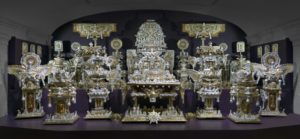For most people, millennial fever passed with New Year’s Eve. But others are still possessed by it. They wait, not for the calendar millennium, but a miraculous one – the thousand-year period, prophesied in the Bible, in which evil will be banished from the Earth and Christ will reign.
The prophesy, if that’s what it is, is found in the Book of Revelation at the end of the New Testament. Fundamentalist Christians, who take the Bible literally, have have been vigilant for centuries, watching for portents from above – comets, meteor showers, and the like. Once, even non-believers feared the end was at hand on the famous “Dark Day” of May 19, 1780, when the sun failed to appear across a swath of the Northeast, apparently the result of forest fires and a weather inversion.
This is the kind of background you need to bear in mind to fully appreciate “Millennial Dreams: Vision and Prophecy in American Folk Art.” Many of the self-taught artists and craftsman in it were fervent believers, their imaginations inflamed by Revelation’s apocalyptic prophesies, such as this one, projected on the floor at the exhibit’s entrance: “And I saw an angel come down from heaven, having the key to the bottomless pit and great chain in his hand. And he laid hold on the dragon, that old serpent, which is the Devil, and Satan, and bound him a thousand years…”
 The 75 works in the show, some from as far back as the 1700s, range from images of trumpeting angels to multiheaded beasts, from city plans of the heavenly New Jerusalem to chronological charts of history’s progress in millennialist terms.
The 75 works in the show, some from as far back as the 1700s, range from images of trumpeting angels to multiheaded beasts, from city plans of the heavenly New Jerusalem to chronological charts of history’s progress in millennialist terms.
It would be wrong, however, to think that millennialism was the sole province of wild-eyed preachers or doomsday cults. A less apocalyptic school of thought held that Christ’s Second Coming would occur only after mankind had earned the passage into heaven by a thousand years of good behavior. This notion melded with America’s belief in itself as a new beginning for the world, and fueled the nation’s utopian and reformist spirit.
The show begins with Gabriel, the horn-blowing archangel who heralds the millennium’s arrival. Weather vanes in his shape, as flat as paper cutouts, were often perched atop church steeples in late 18th and early 19th century New England. These are curious, almost comical figures – some male, some female, some cherubim – as ungainly as storks, with curved beaky noses, and long legs trailing behind.
Some of the artists here were rural preachers, such as the Oklahoman, William A. Blayney, who made elaborate charts to illustrate the millennialist idea that history is the unfolding of a divine plan. If you saw a proselytizer holding up this placard, you’d probably run away. But in the safety of the museum, it’s fun to look at. It’s as dense with information as one of those laminated study sheets, with text, and headings, and arrows, and lots of little cartoonish panels illustrating prophecies about angel armies, dragons, and blackened-out suns. Blayney was as proud of his creation as he was blind to aesthetics, as can be seen from the crude scrawl across the painting’s surface: “All Rights Reserved.”
Visionary folk artists are a colorful breed and this group is especially so. There’s Chester Cornett of Dwarf County, Ky., a chair maker who dreamed that eastern Kentucky was going to be engulfed by a great flood and built a 20-foot ark to save himself and his family. There’s Harriet Powers, a former slave, whose Biblical quilt shows people cringing and gesticulating during hailstorms, meteor showers, and other unusual occurrences believed to be portents of the millennium. She used a shorthand, symbolic style, not unlike that of graffiti artist Keith Haring, in which falling stars look like country fair ribbons, and the frightened people look like Gumby.

Washington, D.C., janitor James Hampton spent 14 years secretly constructing “The Throne of the Third Heaven of the Nations Millennium General Assembly” out of discarded furniture and used light bulbs that he lovingly wrapped in gold and aluminum foil. The weirdly exotic piece, now an icon of religious folk art, looks part Flash Gordon, part Angkor Wat. Up close, you can see that, yes, it’s just plain old aluminum foil, the same stuff you played with as a child, which is part of its charm. You find yourself remembering how easily shaped it was, but how, once crinkled, it could never be made smooth and shiny again, no matter how much you flattened it.
At the center of the show is a version of Edward Hicks’ “The Peaceable Kingdom,” one of about 60 such images he made. Hicks was one of those itinerant 19th century limners – a painter of signs and decorative patterns. His vision was post-apocalyptic, a heaven on Earth, in which lions and lambs literally lie down together. This painting and its variants are icons of American art, a seemingly strong and original statement. So, it’s ironic to learn that Hicks borrowed his imagery from two paintings, Benjamin West’s “William Penn’s Treaty with the Indians” and Richard Westall’s “The Peaceable Kingdom of the Branch.” Folk artists are forever surprising and confounding us.
The Museum of American Folk Art
2000

